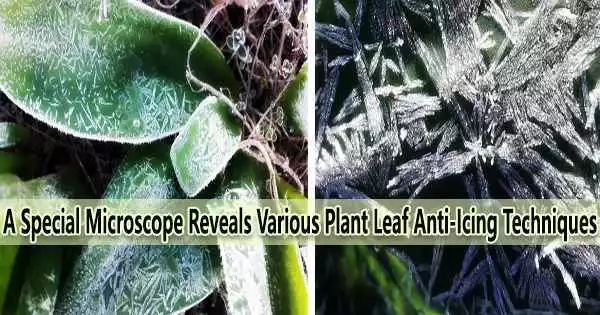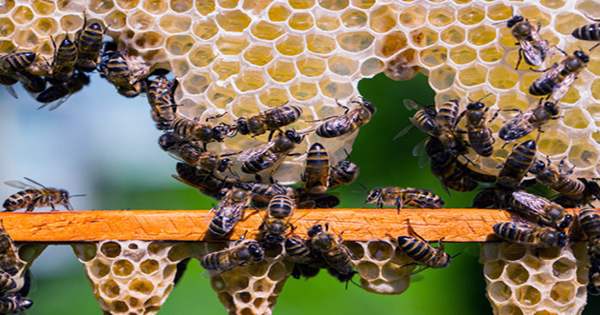A special microscope reveals various plant leaf anti-icing techniques. Nevertheless, they usually survive frost phases unharmed. Using a special cryo-scanning electron microscope, researchers from the Zoological Institute of Christian-Albrechts-Universität zu Kiel (CAU) were able to take high-resolution images of icing processes on surfaces of plants native to Germany and Antarctica at the micro and nanoscales for the first time. They found numerous small structures on the leaf surfaces that the plants use to defend themselves from cold temperatures.
For the protection of crops or man-made surfaces like airplanes, a deeper knowledge of these defense mechanisms would be interesting. The results were published in the journal The Science of Nature.
Inspiration for artificial anti-icing surfaces
To prevent icing, planes are coated with specific liquids or have surfaces that can be heated. Science and industry worldwide are investigating suitable coatings for aviation.
“However, many of our wild plants have developed their own natural protection against icing over the course of evolution,” explains Professor Stanislav Gorb, head of the research group Functional Morphology and Biomechanics. For more than 20 years, the zoologist has been studying the surfaces of plants at CAU together with his wife Dr. Elena Gorb, a botanist by training.
Research to date has primarily focused on chemical reactions occurring in plant cells, such as the presence of sugar or other antifreeze components, to learn how plants defend themselves against icing.
The study team from Kiel has now been able to demonstrate that the leaf’s surface structure serves an essential defensive purpose in cold climates. The two researchers looked at how ice crystals formed on several native wild plant leaf varieties for this aim.
Ultimately, plants have developed many ways to protect themselves from the cold in the course of evolution. The interactions with water on the leaf surface promise exciting insights, especially for the development of technical ‘anti-icing’ surfaces. But we still know very little about these processes.
Professor Stanislav Gorb
“We could show that fine hairs, so-called trichomes, or a waxy layer on the leaves are effective adaptations of plants to prevent or control icing directly on the leaf surface. If a layer of ice forms directly on the cuticle, the plant’s cells will soon freeze as well,” says Elena Gorb.
Leaf surfaces developed different adaptations
The two researchers were able to distinguish various defensive systems on the leaves through experiments in nature and the lab.
Plant leaves with trichomes, such as those of the daisy (Bellis perennis), are usually hydrophilic. Hence, when temperatures rise again, ice crystals first form at their tips and melt swiftly there as well. The delicate leaf surface below is unaffected and unaffected by the ice.
Leaf surfaces covered with 3D nanoscale wax projections, such as those of some tulip species (Tulipa gesneriana), on the other hand, are superhydrophobic: Water drops roll off immediately, also known as the “lotus effect.” Water molecules must be blocked by flaws in the wax layer for ice crystals to develop in this environment. Even yet, the wax covering is unharmed, and the leaf beneath is unharmed.
The scientists found the anti-icing wax strategy of plants not only in Germany, but also at the Antarctic Circle: Deschampsia antarctica, one of the only two flowering plants native to Antarctica, even has a double protection with a prominent epicuticular wax coverage consisting of two superimposed layers on both leaf sides.
In a different recent article in Beilstein Journal of Nanotechnology, the researchers hypothesize that the two-layered wax may help the plant adapt to harsh environmental conditions in Antarctica even more because it increases its resistance to cold temperatures, icing, harmful UV radiation, and dehydration.
Plants with relatively smooth leaves such as the cherry laurel (Prunus laurocerasus) are the least protected at first glance: Ice crystals can form all over the surface. When exposed to sunshine, the meltwater gathers in the leaf’s lower-lying regions. These “puddles” freeze as the temperature drops once more, which can harm the plant’s cells permanently.
“But since such plants survive the winter, we think they have sufficient chemical antifreeze protection,” Stanislav Gorb says.
Cryo-microscope enables images at minus 140 degrees
The team was limited to using a cryo-scanning electron microscope to analyze the tiny ice crystals. In contrast to previous techniques, biological samples are promptly frozen here rather than dried. As a result, their structures are fairly well preserved and may be studied practically exactly as they were originally.
The researchers did this by momentarily submerging the leaves in liquid nitrogen heated to minus 196 degrees. High-resolution pictures of the resulting ice crystals could now be captured in the microscope, which had been chilled to minus 140 degrees.
At room temperature, the ice crystals melt again and the process can be repeated. On this method, a natural intermediate melting, such as that caused by sunshine during the day, can be simulated.
“Ultimately, plants have developed many ways to protect themselves from the cold in the course of evolution,” Stanislav Gorb says. The interactions with water on the leaf surface promise exciting insights, especially for the development of technical ‘anti-icing’ surfaces. “But we still know very little about these processes.”
















